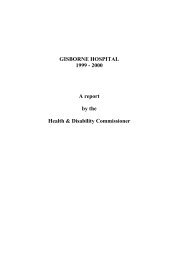09HDC01565 - Health and Disability Commissioner
09HDC01565 - Health and Disability Commissioner
09HDC01565 - Health and Disability Commissioner
Create successful ePaper yourself
Turn your PDF publications into a flip-book with our unique Google optimized e-Paper software.
<strong>Health</strong> <strong>and</strong> <strong>Disability</strong> <strong>Commissioner</strong><br />
opportunity to ask questions, <strong>and</strong> he again mentioned his concerns about the risk of<br />
paralysis. Dr F states that Mr A initially agreed to postpone the operation, but at the<br />
conclusion of the meeting said that he wished to proceed. Mr A then signed the<br />
consent form that Dr F had prepared during their earlier meeting.<br />
36. The risks are listed on the consent form (see Appendix 3) as: ―Infection, CSF leak,<br />
neurological deficit, bleeding/haematoma, stroke, anaesthetic risk, AMI [acute<br />
myocardial injury], DVT [deep vein thrombosis]/PE [pulmonary embolism], chest<br />
infection. May not help headaches.‖<br />
37. Dr F subsequently acknowledged that his documentation of the risks was not<br />
complete in terms of respiratory risk <strong>and</strong> death. He states that although the risk of<br />
death was mentioned several times with respect to other complications, he used the<br />
terms ―risk to life‖ or ―life-threatening‖ rather than ―death‖. Dr F considers that Mr<br />
A‘s apprehension indicated that he understood the gravity of the implications of the<br />
operation, <strong>and</strong> in particular the risks <strong>and</strong> potential complications. He does not think<br />
Mr A was under the impression that he was to undergo ―minor surgery‖.<br />
38. The consent form also states: ―I acknowledge that an assurance has not been given<br />
that the procedure will be performed by a particular doctor, but that doctor will,<br />
however, have appropriate experience.‖<br />
39. Dr G observed the consent process but did not participate. Although he does not<br />
remember the specifics that were discussed, he cannot recall anything unusual or out<br />
of the ordinary about the conversation.<br />
40. Mrs C was not present for Dr E‘s meeting with Mr A. She said that her son had<br />
phoned after the meeting with Dr E to say he was going ahead with the operation, <strong>and</strong><br />
that when she <strong>and</strong> her husb<strong>and</strong> visited later that evening, he was relaxed <strong>and</strong><br />
comfortable.<br />
41. Mrs C said that when her son first told her <strong>and</strong> her husb<strong>and</strong> about the operation, he<br />
said it was a small operation to take away his headaches, with the normal risks that<br />
come with general surgery. Mrs C does not believe her son was informed about the<br />
risk of respiratory failure, <strong>and</strong> that with his history of asthma <strong>and</strong> respiratory<br />
problems, had he known this, he would not have agreed to the surgery. She considers<br />
the only reason her son wanted the surgery was to return to work. She states that Dr E<br />
assured him that this would happen.<br />
42. Mrs C also states that she <strong>and</strong> her son were under the impression that Dr E would be<br />
performing the surgery himself, <strong>and</strong> that her son had chosen Dr E because he was<br />
originally from the same country. Dr E advised HDC that he never told Mr A or his<br />
mother that he would be performing the surgery personally, <strong>and</strong> nor did he state the<br />
opposite. He said that, if asked, he would have told Mr A that the surgery would be<br />
performed using a ―team approach‖. Dr E also asserted that, given the post mortem<br />
findings did not point to any surgical mishap, ―the question as to whether [Mr A] was<br />
aware of the precise makeup of the surgical team or not is actually not relevant‖.<br />
5 September 2012 8<br />
Names have been removed (except Canterbury DHB <strong>and</strong> the experts who advised on this case) to<br />
protect privacy. Identifying letters are assigned in alphabetical order <strong>and</strong> bear no relationship to the<br />
person’s actual name.
















